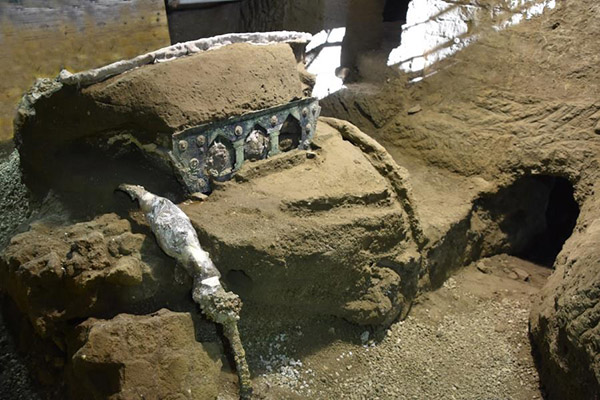The latest stunning discovery in the ruins of Pompeii is a four-wheeled ceremonial chariot. Remarkably intact, the chariot was uncovered in the suburban villa of Civita Giuliana, north of the city of Pompeii.
Pompeii was a Roman city whose main economic engine seems to have been tourism as it functioned as a resort for the wealthiest citizens of Rome. But Pompeii was located only five miles from Mt. Vesuvius, an active volcano that has erupted more than 50 times throughout history.
When Vesuvius erupted in 79 AD, thick ash, pumice and rocks fell on the city – slowly at first. Most of the 12,000 people estimated to have been in the city and the surrounding area had time to escape. As the ash continued to fall, breathing became more difficult.
From the beginning, the excavation of the room where the chariot was found revealed its exceptional nature: the area is a double-level portico which opens onto an uncovered courtyard, and which features the carbonised wooden ceiling with its network of beams, preserved entirely. pic.twitter.com/KpoKxF5y5n
— Pompeii Sites (@pompeii_sites) March 2, 2021
Soon a pyroclastic surge sped down the mountain at 100 miles per hour. The surge contained superheated poisonous gas and crushed rocks. When the whole event was over, Pompeii was buried under millions of tons of ash.
2,000 people died in Pompeii with around 16,000 people killed in total by the eruption.
The area remained abandoned for almost 2,000 years before explorers discovered it in 1748. What they found was a remarkably preserved town whose artifacts, buildings and even skeletons had been protected from the elements by the suffocating ash. Archaeologists have even uncovered jars of preserved fruit and loaves of bread.
The carbonised wooden structure of the door on the southern side of the room, which connected the portico to the stable where the three equids were recently discovered, was also preserved, and upon analysis was identified as beechwood. pic.twitter.com/3s0V30SYsF
— Pompeii Sites (@pompeii_sites) March 2, 2021
The chariot that was recently discovered is likewise remarkably preserved. The iron, bronze and tin components of the chariot are all there. Mineralized remains of the wooden parts are there, too. Even imprints from the ropes and floral decorations were found.
It is one of the best preserved items yet unearthed from Pompeii.
The discovery of the chariot was the result of a unique collaboration between the Public Prosecutor’s Office of Torre Annunziata and The Archaeological Park of Pompeii. The archaeologists are working with the prosecutors because of the high amount of looting that has been going on in the area.
Looters have been digging tunnels and unearthing relics and artifacts and stealing away with them. Two of these tunnels pass by on either side of the chariot’s location so it is quite fortunate that the archaeologists found it first.
https://www.youtube.com/watch?v=glNLEmXxFd8
Archaeologists are working every weekend in the area partly to discourage looters and also to uncover a significant villa in the area around Vesuvius.
In excavating the villa, researchers have been able to determine the extent of the illegal tunnels and have testified for the prosecutor’s office in court.
Because of the fragile nature of the chariot, excavators had to use a technique known as micro-excavation to carefully chip away the hardened ash.
Once they were able to remove the chariot safely from the rock, they sent it to the Archaeological Park of Pompeii’s laboratory to remove the remaining rock which still covers certain parts of the chariot. They will then begin the long process of restoring and reconstructing it.
Another Article From Us: Incredible – McDonald’s Opens Restaurant Which Includes an Ancient Roman Road
Researchers believe that the chariot may be the Pilentum referred to in ancient texts. The Pilentum was not used for day-to-day activities but for festivals, parades and processions – possibly for marriages.
